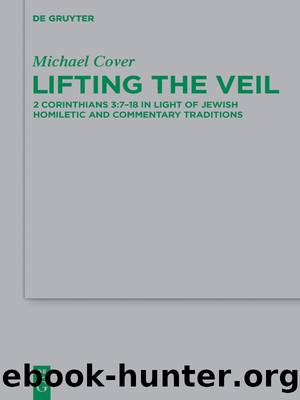Lifting the Veil by Michael Cover

Author:Michael Cover
Language: eng
Format: epub
Publisher: Walter de Gruyter
Published: 2015-02-15T00:00:00+00:00
5.2.52 Cor 3:7â18 in Light of Hebrews
The rhetorical sandwiching of Heb 3:7â4:11 within the larger homiletic unit of Heb 3:1â4:13 parallels the similar phenomenon in 2 Cor 2:14â4:6 and thus offers a more useful analogue than Deus 86â103. Two initial points of difference, however, between these texts need to be initially highlighted as well. First, unlike 2 Cor 3:7â18, Heb 3:7â4:11 includes a full citation of its underlying pericope (LXX Ps 94:7â11). Second, Hebrews interprets a non-pentateuchal text. In these two important respects, Deus 87â90 and 2 Cor 3:7â18 stand in closer proximity.
Unlike Deus 87â90, however, Heb 3:7â4:11 does not complement the exposition of a primary lemma, but amplifies a homiletic synkrisis (Heb 3:1â6). This more closely mirrors Paulâs amplification of his apostolic apology (2 Cor 2:14â 3:6) in 2 Cor 3:7â18, which involves a comparison of two kinds of apostolic authority. This is not to say that the arguments of Heb 3:1â6 and 2 Cor 3:1â6 have no basis in scripture. As mentioned above, Heb 3:1â6 offers an interpretation of Num 12:7, just as 2 Cor 3:1â6 echoes and interprets both Jer 31[38]:31, 33 and Ezek 11:19; 36:26. In this sense, both Heb 3:7â4:11 and 2 Cor 3:7â18 are rightly considered secondary-level expositions within their own contexts. Given their nonscholastic settings, however, both interpretations no longer follow an actual primary lemma, but a scripturally-based thematic discourse. Thus, while the internal form of 2 Cor 3:7â18 agrees more closely with a pattern known from Philo (Deus 87â90, etc.), its literary framing more nearly aligns with the homiletic/epistolary form of Heb 3:1â4:13.
Hebrews also illuminates a further feature of Paulâs epistolary framing of 2 Cor 3:7â18: the coda of 2 Cor 4:1â6. As mentioned above, 2 Cor 4:1â6 draws on elements of Paulâs commentary (2 Cor 3:7â18) and applies them to his apology. Thus, in his Corinthian context, Paul can now speak of the âveilingâ (2 Cor 4:3bis) of his gospel, the âimageâ (2 Cor 4:4) of God, minds and hearts as the real locus of veiling/darkening (2 Cor 4:4, 6), and the âgloryâ (2 Cor 4:4, 6) and âfaceâ (2 Cor 4:6) of Christ. These new themes are interwoven with themes taken from the opening frame as well (2 Cor 2:14 â3:6), such as âself-recommendationâ (2 Cor 3:1, 4:2) and the soteriological category of âthe perishingâ ( : 2 Cor 2:15; 4:3).
We find a partial parallel to Paulâs epistolary coda (2 Cor 4:1â6) in Heb 4:11â 13. However, while Heb 4:11 recapitulates a few major themes from the homily, these are not integrated with themes from the opening frame.539 Heb 4:12â13, for its part, is a relatively independent and âelaborate bit of festive prose.â540 It is only when the Christological discourse resumes in Heb 4:14â16 that the themes of Jesusâ high priesthood and Christian parrhÄsia from the opening synkrisis (: Heb 3:1, 4:14, 15; : Heb 3:6, 4:16) and the notion of âtrialâ from the Psalms homily (n: Heb 3:8, : Heb 4:15) are woven together to create the amplified portrait of Christ, the wilderness-tested high priest.
Download
This site does not store any files on its server. We only index and link to content provided by other sites. Please contact the content providers to delete copyright contents if any and email us, we'll remove relevant links or contents immediately.
Machine Learning at Scale with H2O by Gregory Keys | David Whiting(4257)
Never by Ken Follett(3875)
Fairy Tale by Stephen King(3305)
The Man Who Died Twice by Richard Osman(3039)
Reminders of Him: A Novel by Colleen Hoover(3010)
Will by Will Smith(2872)
Rationality by Steven Pinker(2326)
Can't Hurt Me: Master Your Mind and Defy the Odds - Clean Edition by David Goggins(2267)
It Starts With Us (It Ends with Us #2) by Colleen Hoover(2252)
Friends, Lovers, and the Big Terrible Thing by Matthew Perry(2178)
The Becoming by Nora Roberts(2148)
The Stranger in the Lifeboat by Mitch Albom(2089)
Love on the Brain by Ali Hazelwood(2020)
New Morning Mercies: A Daily Gospel Devotional by Paul David Tripp(1898)
HBR's 10 Must Reads 2022 by Harvard Business Review(1820)
The Strength In Our Scars by Bianca Sparacino(1817)
A Short History of War by Jeremy Black(1815)
Never Finished: Unshackle Your Mind and Win the War Within by David Goggins(1675)
A Game of Thrones (The Illustrated Edition) by George R. R. Martin(1658)
